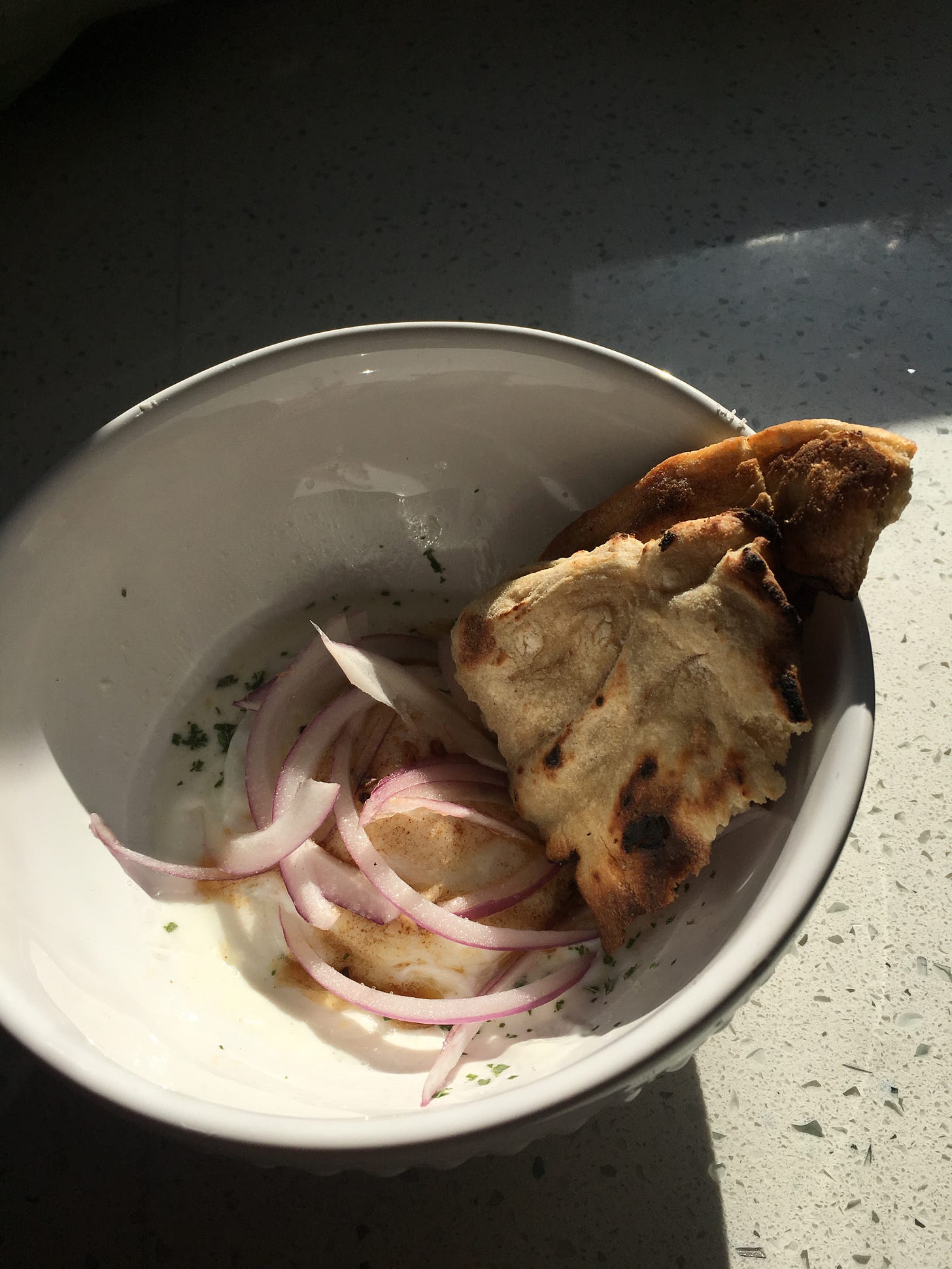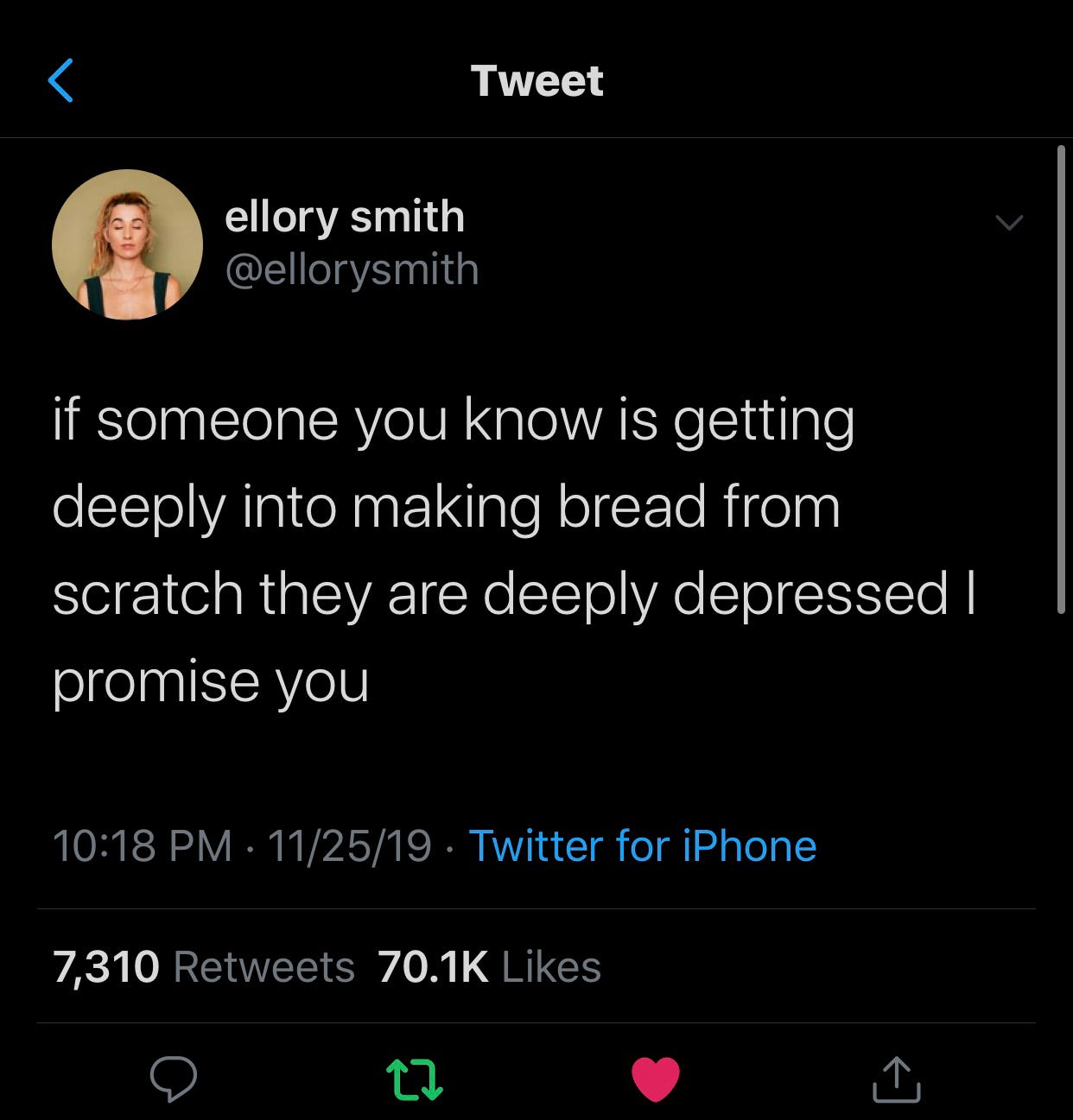Sourdough Flatbreads

(Turkish eggs with sourdough flatbread)
A few things are changing here at On Gurney Hill: I’m going to write more about cooking, and include recipes, because you can’t really run a gardening newsletter year-round on the East Coast. I’m also introducing paid subscriptions: If you want to receive an essay and an accompanying recipe on a weekly basis, you can sign up for $5/month. I really appreciate your support!
There are three rather foundational things in my life that I learned to love because of my dad, and all three tie into my writing on the whole, but especially what I write about in this newsletter. If it weren’t for him, I might not have my love of cooking, gardening, and baking, and we probably wouldn’t be right here, right now, talking about bread.
I think it’s reasonably fair to say that, in the 1990s, some of the best bread in Iowa came out of my dad’s home oven. Growing up eating chewy, crunch, sour loaves certainly helped establish my preference in carbs, and after the no-knead revolution happened all the way back in 2006 (!), I began to make the shift from bread connoisseur to bread baker. For a while, I was the person who bought 50-pound bags of fancy flour from my friend who owned a bakery; at other times, there have been a few dead starters, and too many too flat loaves to count. For the past couple of years, I barely baked at all.

Now, armed with a new starter and perhaps a bit of depression, I’m baking regularly again. But what’s different in this bout of baking is that I haven’t been making the same loaf over and over in the kind of methodical, repetitive, On Kawara-like way that I used to. Any deviations from my standard recipe were minimal in the past, and were generally geared toward getting a higher percentage of whole wheat flour into my loaf. Now, it’s more like, what else can we leaven?
This started partly as a petty response to something dumb I heard recounted about another viral bread recipe, the Samin Nosrat focaccia. You could probably show that sensually shot poking of the olive-oil slicked dough from Salt Fat Acid Heat to the world’s most devoted Wonder Bread stan and they would be at least somewhat interested in making it. So it’s no surprise that, after the Netflix show came out (and the recipe was published), a lot of people started baking focaccia! But what made me feel crazy was when a friend, who works in food, told me he knew someone who was going to *stop* making focaccia because it had become too trendy. Now, even if tech bros have kind of ruined the bread discourse, as Danya Evans wrote about so wonderfully for Eater, I would never let trendiness keep me from something as wonderful as good bread, no matter the shape it takes.
So there have been sheets of sourdough focaccia (still a work-in-progress) alongside pretty near-perfect loaves of half whole-wheat sourdough bread. And there have been various flatbread experiments, ranging from the more naan-like (made with yogurt in the dough) and the more pan-Mediterranean, enriched with olive oil, which can be eaten with caponata and babaganoush alike.
I’ve landed on a dough for the latter that I like a lot: it has enough whole wheat to get some nutty flavor, and a nice chewy-crunchy texture. If rolled thin enough—about a quarter-inch or so—these will balloon like pita in the oven, and the super-heated steam that vents out as the breads deflate has a near-perfect bread smell.
(While I’ve clocked a decent number of hours eating in Little Armenia, and have cooked my fair share of Ottolenghi recipes, I have no real cultural authority here, and I just want to note that.)
Sourdough Flatbreads
makes 8 breads
300 grams white flour (2 1/2 cups)
175 grams whole wheat flour (1 1/4 cups)
12 grams salt (3 teaspoons)
1/4 cup olive oil
1/2 cup bubbly starter
335 grams water (1 1/2 cups)
In a bowl, mix together all of the ingredients. Knead briefly until the dough comes together completely. Return to the mixing bowl and cover with a kitchen towel or plastic wrap. If you’re like me, use a plastic bag from the recycling stash under the sink.
Let the dough rest for fifteen minutes, and then stretch it out and fold it in half. Rotate the hunk of dough 90 degrees and stretch and fold again. Return the dough to the bowl, and let it rest for another fifteen minutes, then repeat the same stretching and folding steps.
Now’s the time to leave the kitchen: make sure the bowl is covered (plastic is better than cloth for this), and let the dough rise for five hours.
After the first rise, preheat the oven to 500 degrees and put your baking surface in there so it can get super hot. Got a pizza stone? That’s perfect. If not, set a cookie sheet upside down on the oven rack, or you could do the same with a cast-iron skillet so long as the handle allows you to lie it flat. The oven is going to be blazing, and you’re going to be reaching in there a lot, so you don’t want anything with a rim getting in the way and burning your wrists or forearms.
While the oven is heating, flour the counter and dump out the dough. Pat it out into a thick disk, about eight inches in diameter, and cut it quarters and then eights, just like a pizza. A bench scraper is the best tool for this, but a knife works too—just take it easy on your counters. Each little doughy triangle will be one flatbread.
With floured hands, take one triangle and tuck the tip back to the crust-end of the pizza-slice shape, pulling both ends together and rolling them upward into the middle of what will now be a ball of dough. Dust with flour and set aside, then repeat with the other triangles. Cover loosely with a towel or that plastic bag, and let the dough balls rest for 15 minutes. This is less of a full-blown second rise than an opportunity for the gluten in the dough to relax, making it easier to roll out the flatbreads.
Now, you’re ready to bake: add a little more flour to the counter, grab your first ball, and use a rolling pin to roll the dough into a thin circle. How thin? It depends on the texture you’re aiming for: when the flatbreads are about a third-inch thick, they turn out more bread-y and chewy; rolled to about a quarter-inch, they will poof up like pita and get more crunchy around the edges.
Open the oven door, and holding the round of dough on your outstretched hand, quickly and carefully invert it onto the baking surface. Bake until puffy and browned, about 4 to 5 minutes, which will give you ample time to roll out the next flatbread. Repeat with the remaining pieces of dough.
These breads keep well—put them in a ziplock and store in the fridge—but chances are you’ll finish them off pretty quickly.
Want more recipes like this? Please subscribe! Later in the week, I’ll have a bonus recipe for the egg dish pictured above.

